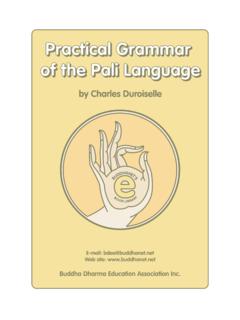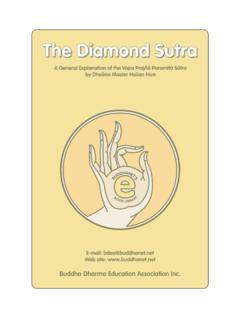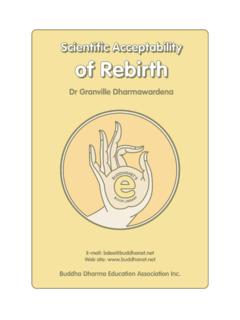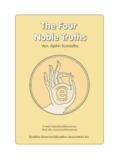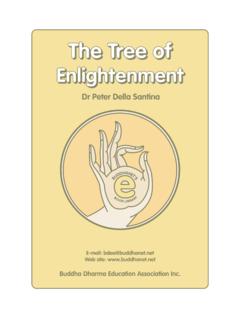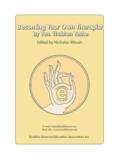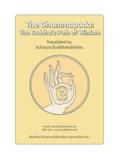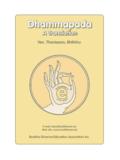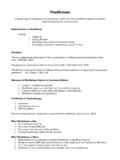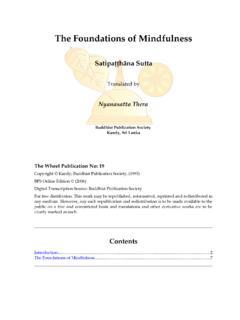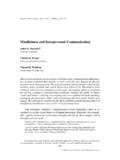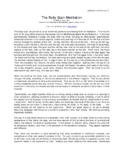Transcription of The Power of Mindfulness by Nyanaponika Thera
1 The Power of Mindfulness Ven. Nyanaponika Thera e DHANET. UD '. B. S. BO Y. O K LIB R A R. E-mail: Web site: Buddha Dharma Education Association Inc. Published in 2001. Sukhi Hotu Sdn Bhd 42V Jalan Matang Kuching 11500 Air Itam, Penang. Tel 604 8277118. Fax 604 8277228. Email: First published in The Light of the Dhamma (Rangoon). Consecutive printings by Wheel Publication, BPS from 1968 1997. Layout by Sukhi Hotu THE. Power . OF. Mindfulness . A N INQUIRY INTO THE. SCOPE OF BARE ATTENTION. AND THE. PRINCIPAL SOURCES OF ITS. STRENGTH.. Nyanaponika Thera . CONTENTS. Introduction .. v Four Sources of Power in Bare Attention 1. The Functions of Tidying and Naming .. 1. Tidying Up the Mental Household .. 1. Naming .. 7. 2. The Non-coercive Procedure .. 12. Obstacles to Meditation .. 12. Three Countermeasures .. 17. 3. Stopping and Slowing Down .. 24. Keeping Still .. 24. Spontaneity .. 35. Slowing-down .. 37. Subliminal In uences .. 42. 4. Directness of Vision .. 47. The Force of Habit.
2 47. Associative Thought .. 54. The Sense of Urgency .. 57. The Road to Insight .. 60. iv INTRODUCTION.. I s Mindfulness actually a Power in its own right as claimed by the title of this essay? Seen from the view- point of the ordinary pursuits of life, it does not seem so. From that angle Mindfulness , or attention, has a rather modest place among many other seemingly more important mental faculties serving the purpose of var- iegated wish-ful lment. Here, Mindfulness means just to watch one's steps so that one may not stumble or miss a chance in the pursuit of one's aims. Only in the- case of speci c tasks and skills is Mindfulness some- times cultivated more deliberately, but here too it is still regarded as a subservient function, and its wider scope and possibilities are not recognized. Even if one turns to the Buddha's doctrine, taking only a surface view of the various classi cations and lists of mental factors in which Mindfulness appears, one may be inclined to regard this faculty just as one among many.
3 Again one may get the impression that it has a rather subordinate place and is easily surpassed in signi cance by other faculties. Mindfulness in fact has, if we may personify it, a rather unassuming character. Compared with it, mental factors such as devotion, energy, imagination, and intel- ligence, are certainly more colourful personalities, mak- ing an immediate and strong impact on people and sit- v uations. Their conquests are sometimes rapid and vast, though often insecure. Mindfulness , on the other hand, is of an unobtrusive nature. Its virtues shine inwardly, and in ordinary life most of its merits are passed on to other mental faculties which generally receive all the credit. One must know Mindfulness well and cultivate its acquaintance before one can appreciate its value and its silent penetrative in uence. Mindfulness walks slowly and deliberately, and its daily task is of a rather humdrum nature. Yet where it places its feet it cannot easily be dislodged, and it acquires and bestows true mastery of the ground it covers.
4 Mental faculties of such a nature, like actual person- alities of a similar type, are often overlooked or under- rated. In the case of Mindfulness , it required a genius like the Buddha to discover the hidden talent in the modest garb, and to develop the vast inherent Power of that potent seed. It is, indeed, the mark of a gen- ius to perceive and to harness the Power of the seem- ingly small. Here, truly, it happens that, what is little becomes much. A revaluation of values takes place. The standards of greatness and smallness change. Through the master mind of the Buddha, Mindfulness is nally revealed as the point where the vast revolving mass of world suffering is levered out of its twofold anchorage in ignorance and craving. The Buddha spoke of the Power of Mindfulness in a very emphatic way: Mindfulness , I declare, is all-helpful. SAMYUTTA, 46:59. vi All things can be mastered by Mindfulness . ANGUTTARA, 8:83. Further, there is that solemn and weighty utterance opening and concluding the Satipa h na Sutta, the Discourse on the Foundations of Mindfulness : This is the only way, monks, for the puri cation of beings, for the overcoming of sorrow and lamentation, for the destruction of pain and grief, for reaching the right path, for the attainment of Nibbana, namely the four foundations of Mindfulness .
5 In ordinary life, if Mindfulness , or attention, is directed to any object, it is rarely sustained long enough for the purpose of careful and factual observation. Gen- erally it is followed immediately by emotional reac- tion, discriminative thought, re ection, or purposeful action. In a life and thought governed by the Buddha's teaching too, Mindfulness (sati) is mostly linked with clear comprehension (sampaja a) of the right pur- pose or suitability of an action, and other considera- tions. Thus again it is not viewed in itself. But to tap the actual and potential Power of Mindfulness it is necessary to understand and deliberately cultivate it in its basic, unalloyed form, which we shall call bare attention. By bare attention we understand the clear and sin- gle-minded awareness of what actually happens to us and in us, at the successive moments of perception. It is called bare because it attends to the bare facts of a perception without reacting to them by deed, speech vii or mental comment.
6 Ordinarily, that Purely receptive state of mind is, as we said, just a very brief phase of the thought process of which one is often scarcely aware. But in the methodical development of Mindfulness aimed at the unfolding of its latent powers, bare atten- tion is sustained for as long a time as one's strength of concentration permits. Bare attention then becomes the key to the meditative practice of Satipa h na, opening the door to mind's mastery and nal liberation. Bare attention is developed in two ways: (1) as a methodical meditative practice with selected objects;. (2) as applied, as far as practicable, to the normal events of the day, together with a general attitude of mindful- ness and clear comprehension. The details of the prac- tice have been described elsewhere, and need not be repeated here.*. The primary purpose of this essay is to demonstrate and explain the ef cacy of this method, that is, to show the actual Power of Mindfulness . Particularly in an age like ours, with its superstitious worship of ceaseless external activity, there will be those who ask: How can such a passive attitude of mind as that of bare attention possibly lead to the great results claimed for it?
7 In reply, one may be inclined to suggest to the questioner not to rely on the words of others, but to put these assertions of the Buddha to the test of personal experience. But those who do not yet know the Buddha's teaching well enough to accept it as a reliable guide, may hesitate to take up, without good reasons, a practice that just on * See Nyanaponika Thera , The Heart of Buddhist Meditation (London: Rider & Co., 1962). viii account of its radical simplicity may appear strange to them. In the following, a number of such good rea- sons are therefore proffered for the reader's scrutiny. They are also meant as an introduction to the general spirit of Satipa h na and as pointers to its wide and signi cant perspectives. Furthermore, it is hoped that he who has taken up the methodical training will rec- ognize in the following observations certain features of his own practice, and be encouraged to cultivate them deliberately.. ix FOUR SOURCES OF Power IN BARE ATTENTION.
8 W e shall now deal with four aspects of bare atten- tion, which are the mainsprings of the Power of Mindfulness . They are not the only sources of its strength, but they are the principal ones to which the ef cacy of this method of mental development is due. These four are: 1. the functions of tidying-up and naming . exercised by bare attention;. 2. its non-violent, non-coercive procedure;. 3. the capacity of stopping and slowing down;. 4. the directness of vision bestowed by bare attention. 1. THE FUNCTIONS OF TIDYING AND NAMING . Tidying Up the Mental Household If anyone whose mind is not harmonized and con- trolled through methodical meditative training should take a close look at his own everyday thoughts and activities, he will meet with a rather disconcerting sight. Apart from the few main channels of his pur- poseful thoughts and activities, he will everywhere be faced with a tangled mass of perceptions, thoughts, feelings, and casual bodily movements showing a dis- orderliness and confusion which he would certainly not tolerate in his living-room.
9 Yet this is the state of affairs that we take for granted within a considera- ble portion of our waking life and our normal mental 1. activity. Let us now look at the details of that rather untidy picture. First we meet a vast number of casual sense-impres- sions such as sights and sounds, passing constantly through our mind. Most of them remain vague and fragmentary; some are even based on faulty perceptions and misjudge- ments. Carrying these inherent weaknesses, they often form the untested basis for judgements and decisions on a higher level of consciousness. True, all these cas- ual sense impressions need not and cannot be objects of focused attention. A stone on the road that happens to meet our glance will have a claim on our attention only if it obstructs our progress or is of interest to us for some reason. Yet if we neglect these casual impressions too often, we may stumble over many stones lying on our road and also overlook many gems. Besides the casual sense impressions, there are those more signi cant and de nite perceptions, thoughts, feelings and volitions which have a closer connection with our purposeful life.
10 Here too, we nd that a very high proportion of them are in a state of utter confu- sion. Hundreds of cross-currents ash through the mind, and everywhere there are bits and ends of un nished thoughts, sti ed emotions and passing moods. Many meet a premature death. Owing to their innately fee- ble nature, our lack of concentration or suppression by new and stronger impressions, they do not persist and develop. If we observe our own mind, we shall notice how easily diverted our thoughts are, how often they behave like undisciplined disputants constantly 2. interrupting each other and refusing to listen to the other side's arguments. Again, many lines of thought remain rudimentary or are left untranslated into will and action, because courage is lacking to accept their practical, moral or intellectual consequences. If we con- tinue to examine more closely our average perceptions, thoughts or judgements, we shall have to admit that many of them are unreliable. They are just the prod- ucts of habit, led by prejudices of intellect or emotion, by our pet preferences or aversions, by laziness or self- ishness, by faulty or super cial observations.
